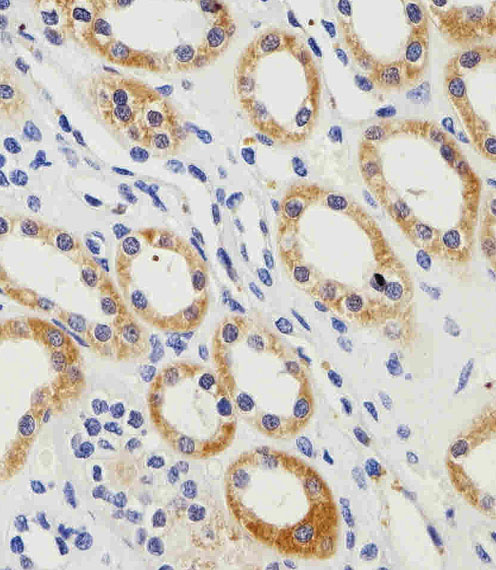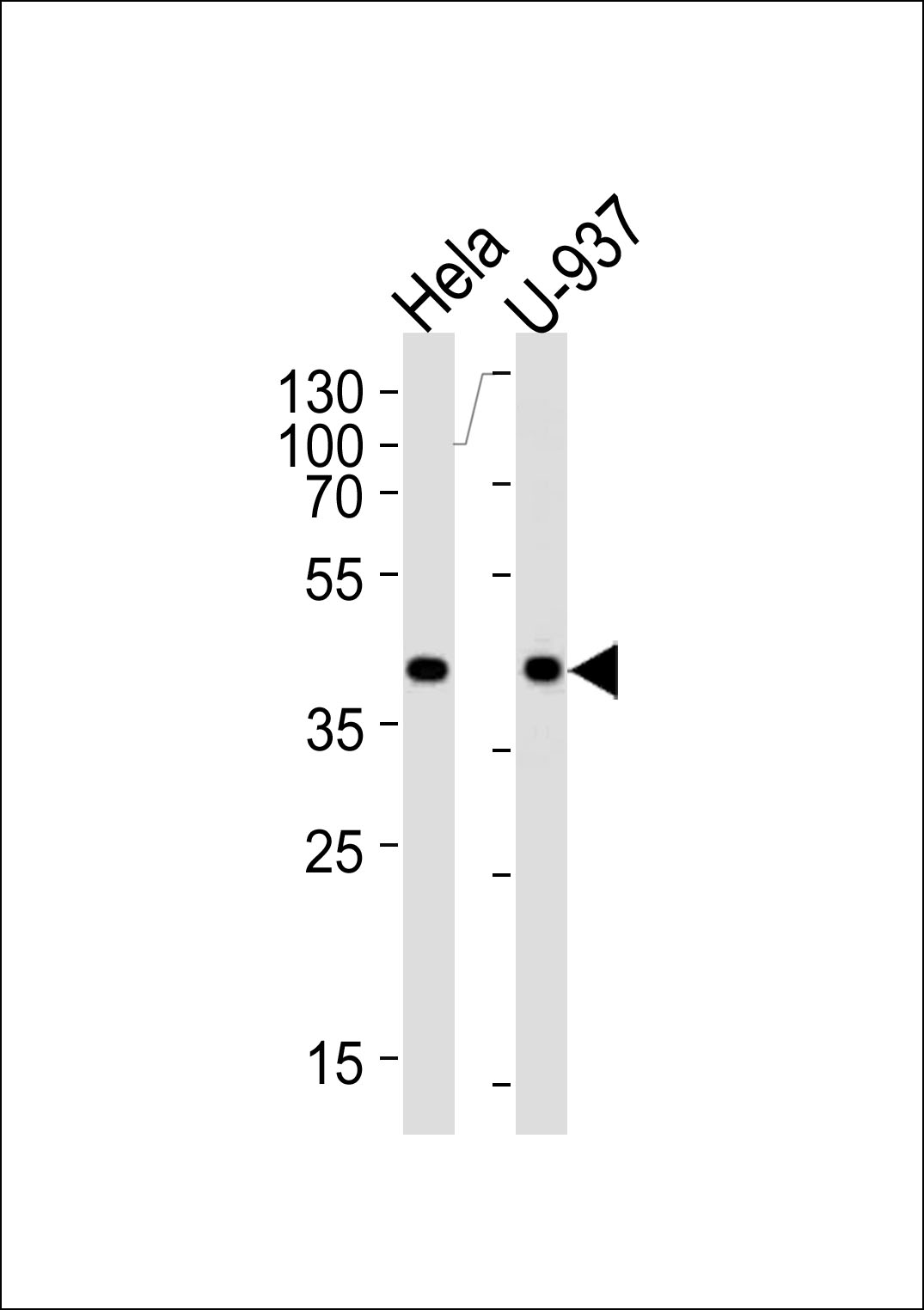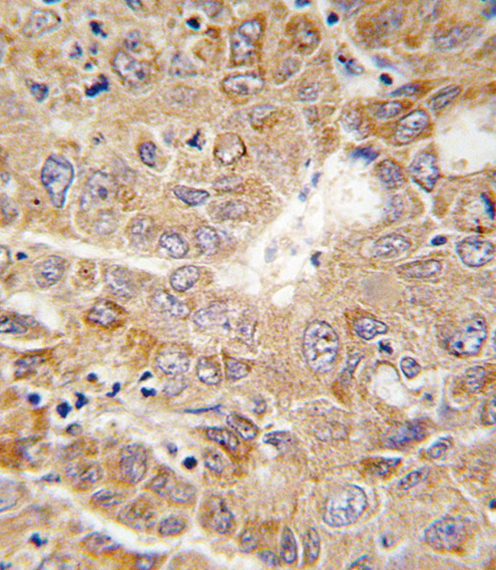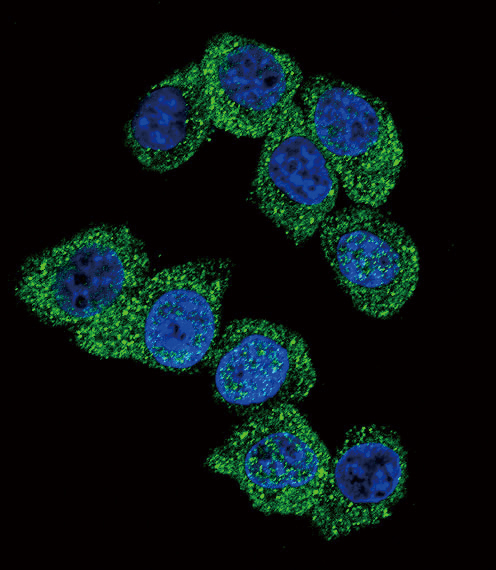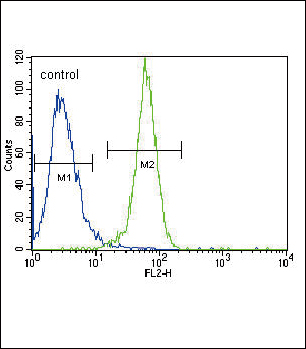PGK1 Antibody (Center)
Purified Rabbit Polyclonal Antibody (Pab)
- 产品详情
- 文献引用 : 9
- 实验流程
- 背景知识
Application
| IHC-P, IF, FC, WB, E |
|---|---|
| Primary Accession | P00558 |
| Other Accession | P16617, P09411, Q60HD8 |
| Reactivity | Human, Rat, Mouse |
| Predicted | Monkey, Rat |
| Host | Rabbit |
| Clonality | Polyclonal |
| Isotype | Rabbit IgG |
| Calculated MW | 44615 Da |
| Antigen Region | 117-145 aa |
| Gene ID | 5230 |
|---|---|
| Other Names | Phosphoglycerate kinase 1, Cell migration-inducing gene 10 protein, Primer recognition protein 2, PRP 2, PGK1, PGKA |
| Target/Specificity | This PGK1 antibody is generated from rabbits immunized with a KLH conjugated synthetic peptide between 117-145 amino acids from the Central region of human PGK1. |
| Dilution | IHC-P~~1:100~500 IF~~1:10~50 FC~~1:10~50 WB~~1:1000 E~~Use at an assay dependent concentration. |
| Format | Purified polyclonal antibody supplied in PBS with 0.09% (W/V) sodium azide. This antibody is prepared by Saturated Ammonium Sulfate (SAS) precipitation followed by dialysis against PBS. |
| Storage | Maintain refrigerated at 2-8°C for up to 2 weeks. For long term storage store at -20°C in small aliquots to prevent freeze-thaw cycles. |
| Precautions | PGK1 Antibody (Center) is for research use only and not for use in diagnostic or therapeutic procedures. |
| Name | PGK1 |
|---|---|
| Synonyms | PGKA |
| Function | Catalyzes one of the two ATP producing reactions in the glycolytic pathway via the reversible conversion of 1,3- diphosphoglycerate to 3-phosphoglycerate (PubMed:30323285, PubMed:7391028). Both L- and D- forms of purine and pyrimidine nucleotides can be used as substrates, but the activity is much lower on pyrimidines (PubMed:18463139). In addition to its role as a glycolytic enzyme, it seems that PGK1 acts as a polymerase alpha cofactor protein (primer recognition protein) (PubMed:2324090). Acts as a protein kinase when localized to the mitochondrion where it phosphorylates pyruvate dehydrogenase kinase PDK1 to inhibit pyruvate dehydrogenase complex activity and suppress the formation of acetyl- coenzyme A from pyruvate, and consequently inhibit oxidative phosphorylation and promote glycolysis (PubMed:26942675, PubMed:36849569). May play a role in sperm motility (PubMed:26677959). |
| Cellular Location | Cytoplasm, cytosol. Mitochondrion matrix. Note=Hypoxic conditions promote mitochondrial targeting (PubMed:26942675). Targeted to the mitochondrion following phosphorylation by MAPK1/ERK2, cis-trans isomerization by PIN1, and binding to mitochondrial circRNA mcPGK1 (PubMed:36849569). |
| Tissue Location | Mainly expressed in spermatogonia. Localized on the principle piece in the sperm (at protein level). Expression significantly decreased in the testis of elderly men |
For Research Use Only. Not For Use In Diagnostic Procedures.

Provided below are standard protocols that you may find useful for product applications.
BACKGROUND
Also known as ATP:3-phosphoglycerate 1-phosphotransferase (EC 2.7.2.3), this major enzyme in glycolysis catalyzes the reversible conversion of 1,3-diphosphoglycerate to 3-phosphoglycerate, generating one molecule of ATP. New blood vessel formation or angiogenesis is critical for tumor expansion and metastasis. Lay et al. (2000) showed that the plasmin reductase isolated from conditioned medium of fibrosarcoma cells is the glycolytic enzyme phosphoglycerate kinase. They concluded that phosphoglycerate kinase not only functions in glycolysis but is secreted by tumor cells and participates in the angiogenic process as a disulfide reductase.
REFERENCES
Lay, A. J., et al. Nature 408: 869-873 (2000).
终于等到您。ABCEPTA(百远生物)抗体产品。
点击下方“我要评价 ”按钮提交您的反馈信息,您的反馈和评价是我们最宝贵的财富之一,
我们将在1-3个工作日内处理您的反馈信息。
如有疑问,联系:0512-88856768 tech-china@abcepta.com.






















 癌症的基本特征包括细胞增殖、血管生成、迁移、凋亡逃避机制和细胞永生等。找到癌症发生过程中这些通路的关键标记物和对应的抗体用于检测至关重要。
癌症的基本特征包括细胞增殖、血管生成、迁移、凋亡逃避机制和细胞永生等。找到癌症发生过程中这些通路的关键标记物和对应的抗体用于检测至关重要。 为您推荐一个泛素化位点预测神器——泛素化分析工具,可以为您的蛋白的泛素化位点作出预测和评分。
为您推荐一个泛素化位点预测神器——泛素化分析工具,可以为您的蛋白的泛素化位点作出预测和评分。 细胞自噬受体图形绘图工具为你的蛋白的细胞受体结合位点作出预测和评分,识别结合到自噬通路中的蛋白是非常重要的,便于让我们理解自噬在正常生理、病理过程中的作用,如发育、细胞分化、神经退化性疾病、压力条件下、感染和癌症。
细胞自噬受体图形绘图工具为你的蛋白的细胞受体结合位点作出预测和评分,识别结合到自噬通路中的蛋白是非常重要的,便于让我们理解自噬在正常生理、病理过程中的作用,如发育、细胞分化、神经退化性疾病、压力条件下、感染和癌症。
